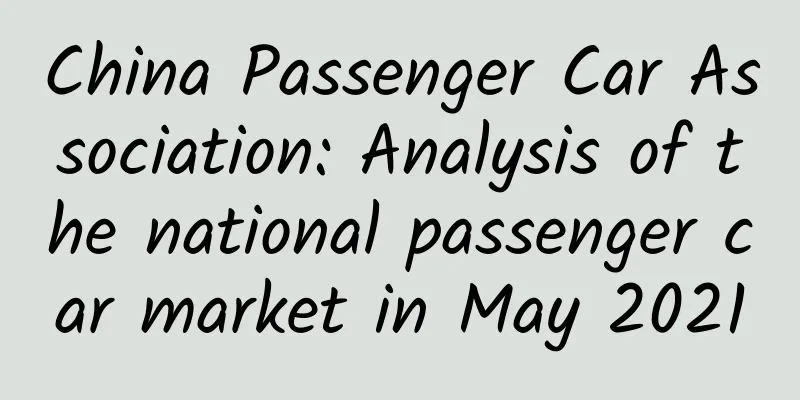|
1. Review of the national passenger car market in May 2021 Retail: In May 2021, the retail sales of the passenger car market reached 1.623 million units, an increase of 1.0% year-on-year from May 2020 and 3% compared with May 2019. The low base increases in previous months were basically eliminated this month. Retail sales in May grew by 1.0% from April, which is basically the same as the average monthly growth rate in previous years and is in line with seasonal patterns. The domestic economic trend this year has been relatively stable, and the economy continues to face downward pressure from the rising base. However, factors such as the lagging overseas epidemic have driven manufacturing exports to maintain strong year-on-year growth, providing a good basic support for auto market consumption. New cars launched before and after the Shanghai Auto Show and the May Day holiday boosted terminal sales, with a significant increase in holiday terminal orders. In May, the Ministry of Commerce and various regions jointly launched a consumption promotion month, and various regions carried out various automobile promotion activities, which boosted the market's popularity. In May, the epidemic situation in Guangzhou and other places in China recurred, and the nationwide epidemic prevention and control measures were further upgraded, which made consumers pay more attention to the safety of travel and social interaction, and also indirectly promoted the auto market. The cumulative retail sales from January to May this year reached 8.364 million vehicles, a year-on-year increase of 38.1%, which is still at the historical high of the growth rate from January to May since 2011 of the China Passenger Car Association. The reason for the super growth from January to May is firstly the low base effect of the cumulative retail sales of the national passenger car market falling by 26% from January to May 2020. Secondly, the contribution of new energy vehicles to the growth has continued to increase, contributing 10 percentage points to the year-on-year growth from January to May. In May, the retail sales of luxury cars reached 260,000, up 13% year-on-year and 2% month-on-month from April, but up 45% from May 2019. Luxury cars continued to maintain strong growth, reflecting the strong demand for high-end replacement purchases due to consumption upgrades. In May, domestic brands sold 600,000 vehicles, up 18% year-on-year, 3% month-on-month from April, and 12% compared to May 2019. Domestic brands accounted for 40.2% of the wholesale market, up 7.7% from the same period last year; and the domestic retail share was 36.4%, up 4 percentage points year-on-year. The leading domestic brands have worked hard to overcome the pressure of chip shortages, and have made significant progress in products, marketing, services and other aspects. Therefore, brands such as Changan, Hongqi, Chery, and GAC Aion have achieved high year-on-year growth. In May, mainstream joint venture brands sold 780,000 vehicles, up 3% year-on-year, up 1% month-on-month from April, and down 1% from May 2019. The retail share of Japanese brands in May was 23.4%, down 2.1 percentage points year-on-year. The retail share of American brands reached 10.6%, up 0.6 percentage points year-on-year, performing well. German brands are still in the stage of adjustment and accumulation. Export: In May, the China Passenger Car Association exported 107,000 passenger cars and CKDs, a year-on-year increase of 250%, and new energy vehicles accounted for 14% of the total exports. Among them, the export of independent brands reached 80,000 vehicles, a year-on-year increase of 241%, and the export of joint venture brands reached 10,000 vehicles, a year-on-year increase of 68%. The export of foreign brands Tesla 11,527 vehicles contributed greatly to the increase. Overseas factory construction promoted the export of passenger car CKDs. In May, Chery Automobile sold 6,840 CKDs, Great Wall Motors sold 3,639, and SAIC Passenger Cars sold 1,425. Other automakers still need to work hard. Production: In May, passenger car production was 1.576 million units, down 2.6% from May 2020, of which luxury brand production increased by 9% year-on-year, joint venture brand production decreased by 22%, and domestic brand production increased by 26%. Cumulative production from January to May was 8.054 million units, up 41.0% year-on-year from 2020. The recent chip shortage has affected the production rhythm, but major manufacturers have adapted to tight times and stabilized production and sales with more flexible measures. In particular, domestic brands have strengthened their supply chain advantages, effectively resolved the pressure of chip shortages, and achieved a good performance of 26% year-on-year production in May. The recent abnormal deterioration of the overseas epidemic, coupled with the continuous supply chain disasters, will lead to further shortages in the supply chain. At present, there is a shortage of supply of a few models. The terminal has actually felt the supply constraints, and the terminal promotion resources have begun to be recovered. However, since the inventory of dealers and secondary circulation links is still relatively sufficient, there has been no obvious impact on retail sales. Wholesale: In May, manufacturers' wholesale sales were 1.606 million vehicles, down 3.1% from April, down 2.1% from May last year, and up 4% from May 2019. Cumulative wholesale sales from January to May were 8.28 million vehicles, up 38.8% year-on-year, the same as the same period in 2019. Recently, manufacturers' inventory assessment constraints have declined. Inventory: Inventory reduction was obvious this year, and some manufacturers cancelled inventory assessments. Manufacturers' inventories continued to decline to a low level in May. At the end of May, manufacturers' inventories decreased by 30,000 vehicles, and channel inventories decreased by 120,000 vehicles; from January to May 2021, manufacturers' inventories decreased by 210,000 vehicles, which was a larger decrease than the inventory reduction from January to May in previous years, forming a feature of strong inventory reduction for four consecutive years. Channel inventory decreased by 510,000 units from January to May 2021, a significant increase from the 290,000 units destocked from January to May 2020. As the problem of chip shortage in the upstream in the short term emerges, at the terminal sales level, there may be further promotion of destocking, discount recovery and other phenomena. New energy: In May, the wholesale sales of new energy passenger vehicles reached 196,000 units, a month-on-month increase of 6.7% and a year-on-year increase of 174.2%, showing a good trend of strong growth. Among them, the wholesale sales of pure electric vehicles reached 162,000 units, a year-on-year increase of 186.1%; the sales of plug-in hybrid vehicles reached 34,000 units, a year-on-year increase of 128.5%, accounting for 17%. In May, the sales of high-end electric vehicles increased strongly, while the trend of mid- and low-end models was not strong. Among them, the wholesale sales of A00-class vehicles reached 50,000 units, accounting for 31% of pure electric vehicles; A-class electric vehicles accounted for 26% of pure electric vehicles, recovering from the bottom; B-class electric vehicles reached 47,000 units, a month-on-month increase of 17% in April, and the pure electric share was 29%. In May, BYD's plug-in hybrid sales reached 13,420 units, a month-on-month increase of 44%, becoming a new highlight of plug-in hybrid growth. In May, the new energy passenger car market diversified, and the performance of large groups' new energy vehicles was differentiated, with SAIC and GAC performing relatively well. Companies with wholesale sales exceeding 10,000 vehicles included Tesla China with 33,463 vehicles, BYD with 32,131 vehicles, SAIC-GM-Wuling with 27,757 vehicles, and SAIC Passenger Vehicle with 11,049 vehicles. In May, the retail sales of new energy passenger vehicles reached 185,000 units, up 177.2% year-on-year and 17.4% month-on-month. Companies with retail sales exceeding 10,000 units include SAIC-GM-Wuling (33,175 units), BYD (31,908 units), Tesla China (21,936 units), and GAC Aion (10,395 units). In May, the export of new energy vehicles showed explosive growth. Tesla China exported 11,527 vehicles, SAIC Passenger Vehicle exported 2,430 new energy vehicles, JAC Motors exported 549 vehicles, BYD exported 223 vehicles, and Aiways exported 143 vehicles. The export of new energy vehicles by other automakers is also gaining momentum. In May, the sales of new car companies such as Weilai, Xiaopeng, Hozon, Ideal, and Leapmotor also performed well year-on-year. Among the mainstream joint venture brands, Volkswagen brand new energy vehicles accounted for 48% of the market share. The pure electric vehicles of BBA luxury car companies are in full mass production, and the product acceptance still needs to be greatly improved. In May, the wholesale of ordinary hybrid passenger cars was 47,000 units, an increase of 81% year-on-year from May last year, and the same as April. Japanese joint ventures were slightly more affected by chips. In May, the domestic retail penetration rate of new energy vehicles was 11.4%, and the penetration rate from January to May was 9.4%, a significant increase from the penetration rate of 5.8% in 2020. In May, the penetration rate of new energy vehicles among domestic brands was 24.7%; the penetration rate of new energy vehicles among luxury cars was 10.8%; and the penetration rate of new energy vehicles among mainstream joint venture brands was only 1.7%. From January to May, the wholesale volume of new energy passenger vehicles reached 857,000 units, a year-on-year increase of 253.3%. From January to May, the retail volume of new energy vehicles reached 776,000 units, a year-on-year increase of 235.7%. 2. Outlook for the national passenger car market in June There are 21 working days among the 30 natural days in June this year. The college entrance examination and the Dragon Boat Festival are at the beginning of the month, so production and sales are relatively stable. July 1st is the 100th anniversary of the founding of the Communist Party of China, and it is also a good time for consumption when the government is in good order and the people are in harmony. With the relative stability of Sino-US relations and the strong development of the domestic economy, the overall consumption in the auto market is strong. However, the pressure of the high base number starting in June has gradually emerged, and the expectation of slowing growth has basically become an industry consensus. Due to the impact of the implementation of the National VI standard on July 1, 2019, retail sales in June were high, and the auto market in June 2020 basically returned to normal seasonal levels. Due to the severe epidemic situation in India and other regions, the domestic awareness of epidemic prevention and control is also increasing. It is expected that domestic self-driving tours and cross-provincial tours during short holidays will still be the main way of family travel in summer, so car life will become more active. Due to continuous destocking, dealers' inventories continued to decrease, and the overall inventory pressure was effectively alleviated. Relying on the target incentives of business policies and the improvement of the quality of order maintenance, retail sales still maintained a good and high level. Although the passenger car market has entered the final half-year period, the chip shortage has not been significantly alleviated due to the continued severe impact of the overseas epidemic. It is difficult for automakers to boost sales. Supply chain security and resilience may become a higher priority topic for automakers in the third quarter of this year. As channel inventory remains at a low level, it is difficult to effectively increase promotional efforts, and therefore consumers' expectations for price promotions when purchasing cars have also decreased. Concerns about price increases have accelerated replacement purchases, and car replacement performance has been strong. 3. The sales forecast for new energy passenger vehicles this year is raised to 2.4 million units From January to May this year, the wholesale sales of new energy vehicles reached 860,000 units, a year-on-year increase of 2.5 times, and the trend was hot. The situation of continuous unilateral increase in the second half of 2020 has turned into a normal seasonal fluctuation pattern this year, which is also a good trend of market demand fluctuations. The strong performance of new energy vehicles is the result of the continued strength of the high-end and low-end markets. In particular, the overall trend of the entry-level new energy vehicle market is stable, and there has been no sharp decline beyond the normal trend. This is also the influence of market-based purchasing power. The A00-class fuel vehicle market in the early stage has obvious seasonal characteristics of off-season and peak season, and the current performance of new energy vehicles is better than expected. The trend of high-end new energy vehicles continued to strengthen, reflecting the relatively strong momentum of the replacement group to purchase high-end electric vehicles. The retail sales of independent mainstream new energy vehicles such as GAC Aion, BYD, and SAIC Passenger Cars continued to strengthen in May, indicating the gradual rise of the main market. Although affected by problems such as chip shortages, new energy vehicles have basically not suffered significant sales losses. The chip supply stability of domestic brands is better than that of joint venture brands, which is why new energy vehicles have stronger growth despite the large amount of chips used. Considering the promotion of Beijing's new energy vehicle family and individual license plate issuance in May, demand for new energy vehicles will remain strong in the coming months. In February, the China Passenger Car Association predicted that the wholesale sales of new energy vehicles would reach 2 million units, and in April it was raised to 2.2 million units, a doubling. The 2.4 million units increase in this forecast is the result of the overall strengthening of various domestic market segments and the increase in exports. In particular, the new energy vehicles of traditional automakers have performed very well recently, such as GAC Aion and SAIC Passenger Cars, which have shown strong performance, gradually showing the endogenous driving force for the continued growth of the new energy market. This year, the exports of foreign-funded and domestic main automakers have shown strong growth, and the exports of new forces are also gaining momentum, so the expected increase in exports of new energy vehicles this year should be 100,000 units. 4. Relaxing the three-child policy is good for China's auto market The central government has decided to further optimize the birth policy and implement a policy that allows a couple to have three children and supporting measures. This will help improve my country's population structure, implement the national strategy of actively responding to population aging, and maintain my country's human resources endowment advantages. The three-child policy is a major boon to the auto market, and is conducive to the growth of the 7-seat car market, especially the 7-seat SUV market. The promotion of the three-child policy encourages rational childbearing and promotes the growth of family cars, which is a definite boost to family cars. At the end of 2020, the Ministry of Public Security’s new policy for the convenience of the people: non-commercial narrow passenger cars with 7-9 seats within 6 years will be included in the 6-year exemption policy. Promote the upgrade of some original 5-seat car groups to 7 seats. The three-child policy will boost the sales of 7-seat passenger cars, especially SUVs, in the short term. In the long run, it will promote changes in fertility concepts and drive the overall growth of family cars. Since the two-child policy for couples with both spouses having no spouse having a child was opened in 2011, the two-child policy for couples with only one spouse having a child was relaxed in 2014, and the universal two-child policy was relaxed in 2016, the auto market has been continuously driven to grow effectively. The auto market reached a retail peak of 2,374 vehicles in 2017, and then began to decline gradually in 2018. As the aging trend of China's population structure is becoming increasingly obvious, the direct incremental effect of the new three-child policy may not be very prominent in the short term, but it is of great significance to curb the decline in the birth rate, stabilize the population structure, and change fertility and consumption concepts. The Chinese auto market has entered an era dominated by middle-aged consumer groups, and is gradually moving towards an automobile consumer market dominated by elderly consumers. Therefore, the country’s introduction of the three-child policy will make the auto market demand more diversified and users’ grasp of their own needs more mature, which is a good thing. 5. China, Europe and the United States are making full efforts in electric vehicles With the continued strong growth of new energy vehicles in China and the 20-year development of new energy vehicles in Europe, the US government recently proposed that it would invest $174 billion in the next eight years to win back the electric vehicle market. The development of the US automobile industry is in line with the major trend of the industry, and we are happy to see greater development and progress in the United States. The previous Trump administration promoted the oil revolution and broke the theory of oil resource depletion, but at the same time it led to the loss of the first opportunity for the development of electric vehicles. The current US government's policy transformation to new energy vehicles is an inevitable trend. The electric vehicle plan launched by the Biden administration can be roughly divided into three parts: the first part is consumer subsidies, the second part is the construction of charging piles across the country, and the third part is to promote the electrification of school buses and public buses. This is similar to China's approach to promoting new energy around 2015. The development of new energy vehicles in China has shifted from being policy-driven to being demand-driven. The core of the accelerated development in the past two years is the promotion of new market-oriented products. In the future, policies to promote new energy should be further strengthened. It is recommended to continue to strengthen the promotion of double points, increase the construction of private charging piles, promote C5 driver's license and other measures in the future to further enhance the development space of new energy. The first is to strengthen the incentive effect of double points and continue to strengthen the market-driven development of new energy. If a sprint effect similar to that in Europe in 2020 occurs, China's passenger cars are expected to increase by more than 2.2 million units year-on-year this year and are expected to reach 2.5 million, with a penetration rate exceeding 10%. Secondly, we should strengthen the construction of charging piles and encourage the development of private charging piles and the upgrading of abandoned charging piles. With the policy requirements of the National Development and Reform Commission and other departments to promote the introduction of charging facilities into residential areas, we should mobilize the enthusiasm of the power sector, reduce the resistance of residential areas, increase the investment in residential charging infrastructure, increase the number of charging stations, and reduce the charging cost. There is a huge space for the popularization of electric vehicles in Chinese cities. Expand the electric vehicle consumer group. As China enters an aging society, the establishment of the C5 driver's license should be accelerated so that more middle-aged and elderly people can get a driver's license to drive electric vehicles. 6. Off-road SUVs open up new markets SUVs have been the main growth driver for China's passenger car market over the past decade, but the growth rate of the SUV market has also been slowing down recently, and there is an urgent need to tap into new consumer growth points such as off-road SUVs. Off-road SUVs have performed well recently, and Great Wall and other off-road SUVs have performed well. The Tank 300 sold 6,090 units in May, leading the market segment. This is actually the resurgence of the original SUV market segment after shrinking. Behind the rise of off-road SUVs is the reflection of the diversified consumer demand in the SUV market. The explosion of off-road SUV products has helped some companies implement their brand power upward strategy. At the same time, it has also filled the long-standing shortage of mid-range off-road SUV products in the Chinese market and the window period brought about by the emission upgrade of high-end off-road SUVs, achieving effective product positioning. As the consumption power of China's middle-aged consumer groups is revealed, the middle-aged characteristics of China's auto market consumption are relatively obvious. The recent high growth of luxury cars and the strong rise of new electric vehicles are both manifestations of the better consumption power of the middle-aged group. The market share of the middle-aged group has increased significantly. The delay in car purchases by young people has led to a smaller scale of car purchases by young people and an increase in the scale of the middle-aged group, which has brought continuous consumption upgrade momentum to the growth of the car market. To guide the release of consumption among the middle-aged group, better product support is needed. Therefore, for domestic brands to break through, they must consider not only the new luxury trend represented by brands such as Hongqi, but also the rise of passenger pickups and off-road SUVs. These markets are new stages for domestic innovation. |










